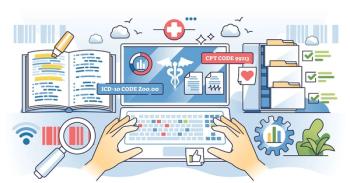
New Versus Established; Split/Shared E&M; 92060 Requirements
Answers from our coding expert on questions regarding new versus established patients; split/shared E&M; 92060 requirements; and same-day admit/discharge.
NEW VS. ESTABLISHED
Q: If we see a patient in the hospital as a new patient, can we charge for a new patient visit for the first office follow up?
A: A lot of providers ask about this. The answer is no, and can be found on the first page of the E&M guidelines in the CPT manual.
It states:"A new patient is one who has not received any professional services from the physician/qualified healthcare professional of the exact same specialty and subspecialty who belongs to the same group practice, within the past three years."
So a patient seen by a member of your group in the inpatient setting would be an established patient when seen in the office.
SPLIT/SHARED E&M
Q: I have been told that, in order to bill a "collaborative" or split/shared E&M in the hospital, I have to fully document or re-document one of the components of the E&M code assigned. That is, the physician performs and documents at least one of the three key components of an E&M service. This seems redundant. Is this truly a requirement?
A: There are several definitions of this found in various Medicare authoritative sources. Here is one of the more common: A split/shared E&M visit is defined by Medicare Part B payment policy as a medically necessary encounter with a patient where the physician and a qualified nonphysician practitioner each personally perform a substantive portion of an E&M visit face-to-face with the same patient on the same date of service. A substantive portion of an E&M visit involves at least one of the three key components (history, exam, or medical decision making).
The exact amount of documentation or work by the physician has always been a bit murky in that Medicare has never precisely stated what percentage of the documentation must be by the billing provider versus the extender.
What strikes me about your question, however, is that I've never heard anyone break it out the way you have, as if the billing provider had to perform a particular segment of the overall documentation, (i.e., exam, versus history, or MDM).
I don't think that's the case. Medicare ranges from "any face-to-face portion of the service" to "personally performs a substantive portion of" when describing split/shared.
The statement that the physician must perform and document at least one of the three key components of an E&M service goes beyond the physician performing a "substantive portion," which involves one of the key elements of an E&M - not is one of the key elements.
My guess is that someone took this one step further than the guidelines require. What payers probably want to see is that the physician has firsthand knowledge of the case, expressed in terms of history, maybe some exam, and certainly some discussion of management. That's the level of participation a payer would want.
Picking one element and measuring it isn't very realistic. From a compliance perspective, I do understand that there needs to be a measurable standard. Stating, "Physicians, if you don't document one component you don't get credit for the service," marks a clear line in the sand.
The bit about "performs and documents one component" is likely an internally derived requirement. I'd recommend checking with your local Medicare Administrative Contractor for more guidance.
92060 REQUIREMENTS
Q: What are the documentation requirements for 92060 (quantitative sensorimotor examination)? How do we see that test in an ophthalmology note?
A: Unless you are very familiar with ophthalmology acronyms and activities these are difficult to see. Ophthalmology notes often have procedures documented on the middle of exam notes. EHRs are helping to sort this out, but many printed templates remain. To improve these notes, be sure to label procedures. What you are looking for are "multiple measurements," mentions of eye movement or ocular deviation. Examples of sensory function testing include Worth 4 Dot, Maddox Rod, and Bagolini lenses. Look for a grid with quadrants and multiple markings in the quadrants.
SAME-DAY ADMIT/DISCHARGE
Q: We have a hospitalist (nocturnist) admitting patients after midnight. Later in the same day, the day-time hospitalist discharges the patient. The first provider documents the admit and bills a same-day admit/discharge code, the second provider has another note, and bills a prolonged services code 99356. Is this allowed?
A: If the first provider documents the admit and includes the time spent on that encounter, that would in part open the door for the second provider to bill for prolonged services. Those codes are allowed with same-day admit/discharge codes. But there is no automatic billing of anything here.
Just because you have two people providing the services within the same calendar day doesn't mean you are going to get two charges or codes out of this - it's just two people performing distinct of the same day code.
The second provider would need to document at least 30 minutes of prolonged services beyond the time required by the same-day admit/discharge code. Without time documented in the first note or the second, this coding scenario fails.
INCIDENT-TO IN NURSING HOMES
Q: We have nurse practitioners seeing nursing home patients and billing incident-to. They discuss these patients with the physicians on the days the physicians are onsite, but not always. Are we allowed to bill this way?
A: Incident-to billing has some pretty specific nursing home requirements. Patients need to be seen in a separate designated area that qualifies as "office" space or POS 11. To satisfy the incident-to criteria, the NPs must see the patients and provide the services in this "designated space" while a physician is onsite. Keep in mind that having a separate office to "discuss" patients does not meet the requirement, the patients must be seen.
It sounds like your nurse practitioners are better off billing directly for their services with place of service 31 and 32. Incident-to claims need to be billed POS 11.
Bill Dacey, CPC, MBA, MHA, is principal in the Dacey Group, a consulting firm dedicated to coding, billing, documentation, and compliance concerns. Dacey is an AAPC-certified instructor and has been active in physician training for more than 20 years.
This article originally appeared in the September 2015 issue of Physicians Practice.
Newsletter
Optimize your practice with the Physicians Practice newsletter, offering management pearls, leadership tips, and business strategies tailored for practice administrators and physicians of any specialty.











